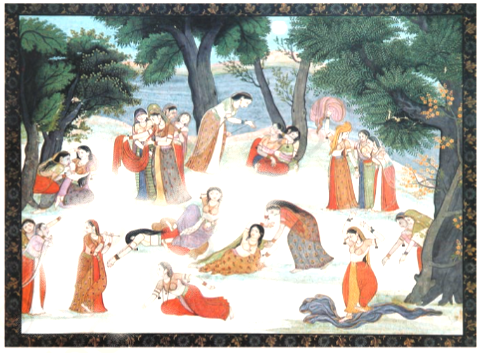The correct answer is Option 1- It transforms into the serpent Kaliya.

About the painting: Re-enacting Krishna’s deeds, Bhagvata Purana, Guler–Kangra, India, 1780–85, Private Collection.
The most magnificent of these cameos to the extreme bottom right, a gopi hurls a blue garment edged with gold over the ground, which takes the form of the multiple hooded serpent Kaliya, upon whom she dances like Krishna.
Re-enacting Krishna’s deeds, Bhagvata Purana, Guler–Kangra, India, 1780–85, Private Collection- This painting is a depiction from Rasa Panchdhyayi, a group of five chapters from the Bhagvata Purana devoted to the philosophical concept of Rasa. It has passages that speak movingly of the love that gopis have for Krishna. Their pain is real when Krishna suddenly disappears. In their forlorn state of separation, they appear utterly devastated with the fruitlessness of search when the deer, trees or creepers, whom they address in their distracted state, do not have answers to their piteous questions regarding the whereabouts of Krishna. With minds engrossed in thoughts of Krishna, the gopis recall and enact his various lilas or feats. Some of them being — the killing of Putana, liberation of Yamala–Arjun after Krishna was tied to a mortar by Yashoda, lifting of Mount Govardhan and rescuing the inhabitants of Braj from the heavy downpour and wrath of Indra, subduing of serpent Kaliya, and the intoxicating call and allure of Krishna’s flute. The gopis take on different roles and emulate his divine sports. The artist captures and evokes these sensitive images exquisitely in this folio. On the extreme left, a gopi enacts Krishna’s part as she bends forward and appears to suck the bosom of another gopi, who plays the role of Putana and raises her hand to the head in response, as if dying while her breath is being sucked away. Next to them, another gopi enacts the character of Yashoda, who along with other gopis, holds out her garment in a gesture of removing the evil eye after the young Krishna performed the brave feat of killing Putana. In the group beside this towards the right, a gopi enacts the mortar to which another gopi, who plays the role of young Krishna, is tied with a cloth band, while his mother admonishingly stands holding a stick in her hands. In the adjoining group, a gopi, sporting a turban, lifts her piled up odhni atop in the guise of lifting Mount Govardhan, while others seek protection underneath. To the extreme left in the bottom, a gopi enacts Krishna, who is playing flute, as some gopis dance and sing, and others crawl towards him, disentangling themselves from their angry mothers-in-law, who try to drag and hold them back from going. In the most magnificent of these cameos to the extreme bottom in the right, a gopi hurls a blue garment edged with gold over the ground, which takes the form of the multiple hooded serpent Kaliya, upon whom she dances like Krishna. |